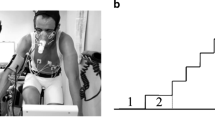Summary
A new method of aerobic threshold (AerT) determination, as a minimum of so-called lactate equivalent (Berg et al. 1980; Lehmann et al. 1983), was compared with the generally used method (AerT1) presented first by Wasserman et al. (1973). The comparison was made with data from 32 subjects in repeated maximal exercise tests on a bicycle ergometer. The AerT as a minimum of lactate equivalent was determined using both a computerized method for curve fitting (AerT3) and visual inspection (AerT2).
AerT2 and AerT3 showed similarity: the regression coefficient was 0.88 and 0.95 and the correlation coefficient was 0.84 and 0.88 in the first and in the second tests, respectively. AerT1 and AerT2 showed similar mean estimated values, but AerT3 showed slightly higher mean values than AerT1 (p<0.05 and p<0.01) or AerT2 (p<0.01). The regression coefficients between AerT1 and AerT2 or AerT3 (0.60–0.71) showed different slopes from the identity (p<0.001). The corresponding correlation coefficients were 0.88 and 0.89 with AerT2, and 0.75 and 0.79 with AerT3 respectively in the first and second tests. However, in two thirds of all determinations the difference between these two estimation methods (AerT1 and AerT2) was <-0.10 1 O2·min−1.
In conclusion, AerT as a minimum of lactate equivalent differed slightly from AerT determined using the traditional method. However, its determination criterion is unambiguous and allows objective computerized curve fitting. The physiological correlates of this new AerT index should be studied carefully before final evaluation of its usefulness in applications can be made.
Similar content being viewed by others
References
Aunola S, Rusko H (1984) Reproducibility of aerobic and anaerobic thresholds in 20–50 year old men. Eur J Appl Physiol 53:260–266
Beaver WL, Wasserman K, Whipp BJ (1985) Improved detection of lactate threshold during exercise using a log-log transformation. J Appl Physiol 59:1936–1940
Berg A, Stippig J, Keul J, Huber G (1980) Bewegungstherapie und ambulante Coronargruppen. 1. Zur Beurteilung der Leistungsfähigkeit und Belastbarkeit von Patienten mit coronarer Herzkrankheit. Dtsch Z Sportmed 31:199–205
Coyle EF, Martin WH, Ehsani AA, Hagberg JM, Bloomfield SA, Sinacore DR, Holloszy JO (1983) Blood lactate threshold in some well-trained ischemic heart disease patients. J Appl Physiol 54:18–23
Davies SF, Iber C, Keene SA, McArthur CD, Path MJ (1986) Effect of respiratory alkalosis during exercise on blood lactate. J Appl Physiol 61:948–952
Davis JA (1985) Anaerobic threshold: review of the concept and directions for future research. Med Sci Sports Exerc 17:6–18
Davis JA, Vodak P, Wilmore JH, Vodak J, Kurtz P (1976) Anaerobic threshold and maximal aerobic power for three modes of exercise. J Appl Physiol 41:544–550
Edwards RHT, Clode M (1970) The effect of hyperventilation on the lactacidaemia of muscular exercise. Clin Sci 38:269–276
Gladden LB, Yates JW, Stremel RW, Stamford BA (1985) Gas exchange and lactate anaerobic thresholds: inter- and intraevaluator agreement. J Appl Physiol 58:2082–2089
Green HJ, Hughson RL, Orr GW, Ranney DA (1983) Anaerobic threshold, blood lactate, and muscle metabolites in progressive exercise. J Appl Physiol 54:1032–1038
Hughson RL (1984) Methodologies for measurement of the anaerobic threshold. Physiologist 27:304–311
Hughson RL, Green HJ (1982) Blood acid-base and lactate relationships studied by ramp work tests. Med Sci Sports Exerc 14:297–302
Kindermann W, Simon G, Keul J (1978) Dauertraining — Ermittlung der optimalen Trainingsherzfrequenz und Leistungsfähigkeit. Leistungssport 8:34–39
Lehmann M, Berg A, Kapp R, Wessinghage T, Keul J (1983) Correlations between laboratory testing and distance running performance in marathoners of similar performance ability. Int J Sports Med 4:226–230
Simon J, Young JL, Blood DK, Segal KR, Case RB, Gutin B (1986) Plasma lactate and ventilation thresholds in trained and untrained cyclists. J Appl Physiol 60:777–781
Simon J, Young JL, Gutin B, Blood DK, Case RB (1983) Lactate accumulation relative to the anaerobic and respiratory compensation thresholds. J Appl Physiol 54:13–17
Wasserman K, Whipp BJ, Koyal SN, Beaver WL (1973) Anaerobic threshold and respiratory gas exchange during exercise. J Appl Physiol 35:236–243
Author information
Authors and Affiliations
Rights and permissions
About this article
Cite this article
Aunola, S., Rusko, H. Comparison of two methods for aerobic threshold determination. Europ. J. Appl. Physiol. 57, 420–424 (1988). https://doi.org/10.1007/BF00417987
Accepted:
Issue Date:
DOI: https://doi.org/10.1007/BF00417987




